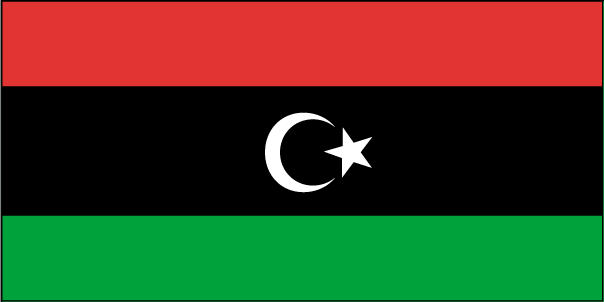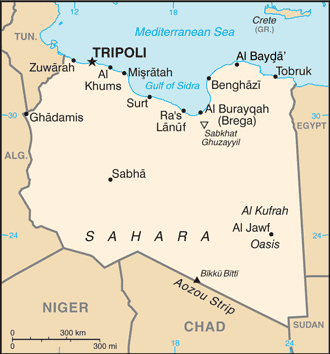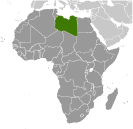
|
|
Advertisements:
GovernmentCountry name
Conventional long form None
Conventional short form Libya Local long form None Local short form Libiya Government type
Operates under a transitional government Capital
Name Tripoli (Tarabulus)
Geographic coordinates 32 53 N, 13 10 E Time difference UTC+2 (7 hours ahead of Washington, DC during Standard Time) Administrative divisions
22 districts (shabiyat, singular - shabiyat); Al Butnan, Al Jabal al Akhdar, Al Jabal al Gharbi, Al Jafarah, Al Jufrah, Al Kufrah, Al Marj, Al Marqab, Al Wahat, An Nuqat al Khams, Az Zawiyah, Banghazi, Darnah, Ghat, Misratah, Murzuq, Nalut, Sabha, Surt, Tarabulus, Wadi al Hayat, Wadi ash Shati Independence
24 December 1951 (from UN trusteeship) Constitution
7 February 2011 draft (temporary) constitution of the Transitional National Council; note - following the September 1969 military overthrow of the Libyan government, the Revolutionary Command Council replaced the existing constitution with the Constitutional Proclamation in December 1969; in March 1977, Libya adopted the Declaration of the Establishment of the People's Authority; in September 2011 the UN recognized the Transitional National Council as the legitimate interim government Legal system
NA
International law organization participation
Has not submitted an ICJ jurisdiction declaration; non-party state to the ICCt Suffrage
NA
Executive branch
Chief of state
Chairman, TNC Mustafa Muhammad Abd al-JALIL (since March 2011) Head of government Prime Minister Abd al-Rahim al-KEEB (since 23 October 2011); Deputy Prime Ministers Amur Abdallah ABD AL-KARIM, Haramayn Muhammad al-HARAMAYM, Mustafa BUSHAGUR Cabinet A new cabinet was formed by the prime minister in November 2011 Elections TNC Chairman al-JALIL in August 2011 announced transitional national assembly elections to be held in June 2012 Election results NALegislative branch
National Congress
Elections First GNC election held on 7 July 2012 (next to be held NA) Election results NAJudicial branch
NA
Political parties and leaders
Note
Includes some of the larger political parties and leaders Al-Watan (Homeland) Party; Justice and Construction Party or PJC [Muhammad SAWAN]; National Front Party [Muhammad al-MAQARAF] (initially the National Front for the Salvation of Libya, formed in 1981 as a diaspora opposition group); Union for the Homeland [Abd al-Rahman al-SUWAYHILI] Political pressure groups and leaders
NA
International organization participation
ABEDA, AfDB, AFESD, AMF, AMU, AU, CAEU, COMESA, FAO, G-77, IAEA, IBRD, ICAO, ICRM, IDA, IDB, IFAD, IFC, IFRCS, ILO, IMF, IMO, IMSO, Interpol, IOC, IOM, IPU, ISO, ITSO, ITU, LAS, MIGA, NAM, OAPEC, OIC, OPCW, OPEC, PCA, UN, UNCTAD, UNESCO, UNIDO, UNWTO, UPU, WCO, WFTU, WHO, WIPO, WMO, WTO (observer) Diplomatic representation in the us
Chief of mission Ambassador Ali Suleiman AUJALI
Chancery 2600 Virginia Avenue NW, Suite 705, Washington, DC 20037 Telephone [1] (202) 944-9601FAX [1] (202) 944-9060 Diplomatic representation from the us
Chief of mission
Ambassador J. Christopher STEVENS Note On 11 September 2012, US Ambassador STEVENS and three other American diplomats were killed in an attack by heavily armed militants on a US diplomatic post in the eastern city of Benghazi Embassy Off Jaraba Street, behind the Libyan-Swiss clinic, Ben Ashour Mailing address US Embassy, 8850 Tripoli Place, Washington, DC 20521-8850 Telephone [218] 91-220-3239Flag description
Three horizontal bands of red (top), black (double width), and green with a white crescent and star centered on the black stripe; the National Transitional Council reintroduced this flag design of the former Kingdom of Libya (1951-1969) on 27 February 2011; it replaced the former all-green banner promulgated by the QADHAFI regime in 1977; the colors represent the three major regions of the country: red stands for Fezzan, black symbolizes Cyrenaica, and green denotes Tripolitania; the crescent and star represent Islam, the main religion of the country National symbol(s)
Star and crescent; hawk
National anthem
Name
"Allahu Akbar" (God Is Greatest) Lyrics/music Mahmoud el-SHERIF/Abdalla Shams el-DIN Note Adopted 1969; the anthem was originally a battle song for the Egyptian Army in the 1956 Suez War
Comments
Add a new comment: |
Advertisement
Members area
Libya (Tripoli):
 
GPS points from Libya (Tripoli)
|
||||||||

 The Italians supplanted the Ottoman Turks in the area around Tripoli in 1911 and did not relinquish their hold until 1943 when defeated in World War II. Libya then passed to UN administration and achieved independence in 1951. Following a 1969 military coup, Col. Muammar Abu Minyar al-QADHAFI began to espouse his own political system, the Third Universal Theory. The system was a combination of socialism and Islam derived in part from tribal practices and was supposed to be implemented by the Libyan people themselves in a unique form of "direct democracy." QADHAFI used oil funds during the 1970s and 1980s to promote his ideology outside Libya, supporting subversives and terrorists abroad to hasten the end of Marxism and capitalism. In addition, beginning in 1973, he engaged in military operations in northern Chad's Aozou Strip - to gain access to minerals and to use as a base of influence in Chadian politics - but was forced to retreat in 1987. UN sanctions in 1992 isolated QADHAFI politically following the downing of Pan Am Flight 103 over Lockerbie, Scotland. During the 1990s, QADHAFI began to rebuild his relationships with Europe. UN sanctions were suspended in April 1999 and finally lifted in September 2003 after Libya accepted responsibility for the Lockerbie bombing. In December 2003, Libya announced that it had agreed to reveal and end its programs to develop weapons of mass destruction and to renounce terrorism. QADHAFI subsequently made significant strides in normalizing relations with Western nations. The US rescinded Libya's designation as a state sponsor of terrorism in June 2006. In August 2008, the US and Libya signed a bilateral comprehensive claims settlement agreement to compensate claimants in both countries who allege injury or death at the hands of the other country, including the Lockerbie bombing, the LaBelle disco bombing, and the UTA 772 bombing. In October 2008, the US Government received $1.5 billion pursuant to the agreement to distribute to US national claimants, and as a result effectively normalized its bilateral relationship with Libya. The two countries then exchanged ambassadors for the first time since 1973 in January 2009. Libya in May 2010 was elected to its first three-year seat on the UN Human Rights Council, prompting protests from international non-governmental organizations and human rights campaigners. Unrest that began in several Near Eastern and North African countries in late December 2010 spread to several Libyan cities in early 2011. In March 2011, a Transitional National Council (TNC) was formed in Benghazi with the stated aim of overthrowing the QADHAFI regime and guiding the country to democracy. In response to QADHAFI's harsh military crackdown on protesters, the UN Security Council adopted Resolution 1973, which demanded an immediate ceasefire and authorized the international community to establish a no-fly zone over Libya. After several months of see-saw fighting, anti-QADHAFI forces in August 2011 captured the capital, Tripoli. In mid-September, the UN General Assembly voted to recognize the TNC as the legitimate interim governing body of Libya. The TNC on 23 October officially declared the country liberated following the defeat of the last remaining pro-QADHAFI stronghold and QADHAFI's death, and plans to transition toward elections, the formation of a constitution, and a new government.
The Italians supplanted the Ottoman Turks in the area around Tripoli in 1911 and did not relinquish their hold until 1943 when defeated in World War II. Libya then passed to UN administration and achieved independence in 1951. Following a 1969 military coup, Col. Muammar Abu Minyar al-QADHAFI began to espouse his own political system, the Third Universal Theory. The system was a combination of socialism and Islam derived in part from tribal practices and was supposed to be implemented by the Libyan people themselves in a unique form of "direct democracy." QADHAFI used oil funds during the 1970s and 1980s to promote his ideology outside Libya, supporting subversives and terrorists abroad to hasten the end of Marxism and capitalism. In addition, beginning in 1973, he engaged in military operations in northern Chad's Aozou Strip - to gain access to minerals and to use as a base of influence in Chadian politics - but was forced to retreat in 1987. UN sanctions in 1992 isolated QADHAFI politically following the downing of Pan Am Flight 103 over Lockerbie, Scotland. During the 1990s, QADHAFI began to rebuild his relationships with Europe. UN sanctions were suspended in April 1999 and finally lifted in September 2003 after Libya accepted responsibility for the Lockerbie bombing. In December 2003, Libya announced that it had agreed to reveal and end its programs to develop weapons of mass destruction and to renounce terrorism. QADHAFI subsequently made significant strides in normalizing relations with Western nations. The US rescinded Libya's designation as a state sponsor of terrorism in June 2006. In August 2008, the US and Libya signed a bilateral comprehensive claims settlement agreement to compensate claimants in both countries who allege injury or death at the hands of the other country, including the Lockerbie bombing, the LaBelle disco bombing, and the UTA 772 bombing. In October 2008, the US Government received $1.5 billion pursuant to the agreement to distribute to US national claimants, and as a result effectively normalized its bilateral relationship with Libya. The two countries then exchanged ambassadors for the first time since 1973 in January 2009. Libya in May 2010 was elected to its first three-year seat on the UN Human Rights Council, prompting protests from international non-governmental organizations and human rights campaigners. Unrest that began in several Near Eastern and North African countries in late December 2010 spread to several Libyan cities in early 2011. In March 2011, a Transitional National Council (TNC) was formed in Benghazi with the stated aim of overthrowing the QADHAFI regime and guiding the country to democracy. In response to QADHAFI's harsh military crackdown on protesters, the UN Security Council adopted Resolution 1973, which demanded an immediate ceasefire and authorized the international community to establish a no-fly zone over Libya. After several months of see-saw fighting, anti-QADHAFI forces in August 2011 captured the capital, Tripoli. In mid-September, the UN General Assembly voted to recognize the TNC as the legitimate interim governing body of Libya. The TNC on 23 October officially declared the country liberated following the defeat of the last remaining pro-QADHAFI stronghold and QADHAFI's death, and plans to transition toward elections, the formation of a constitution, and a new government.